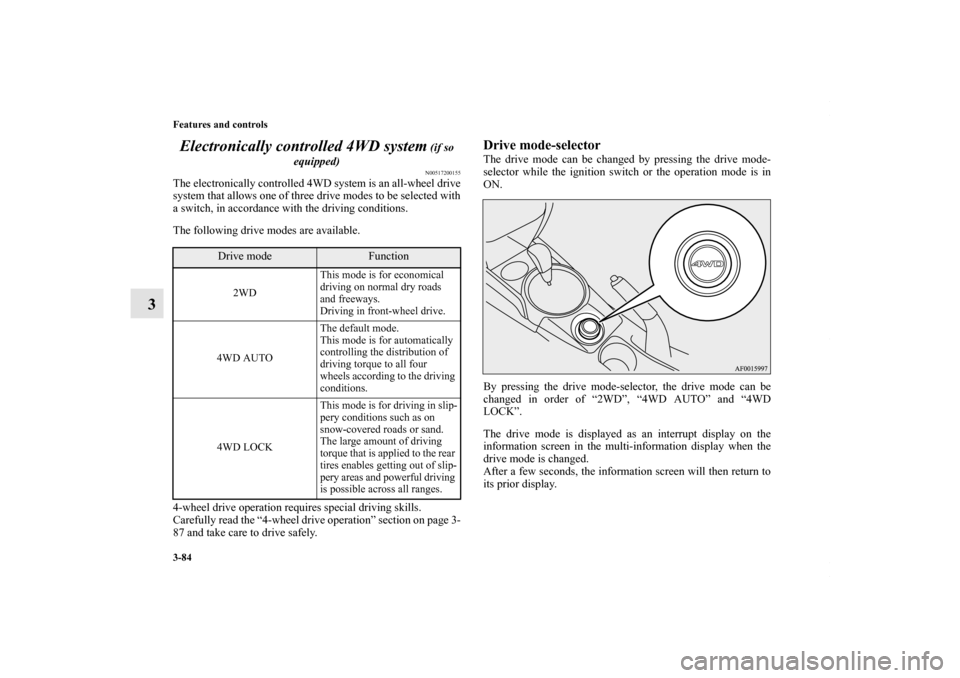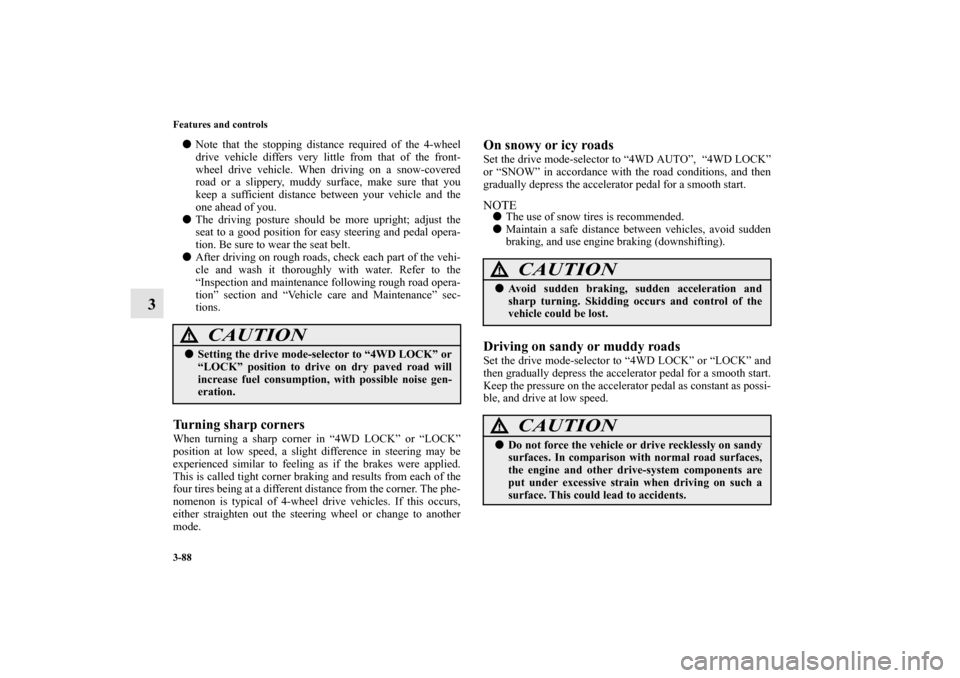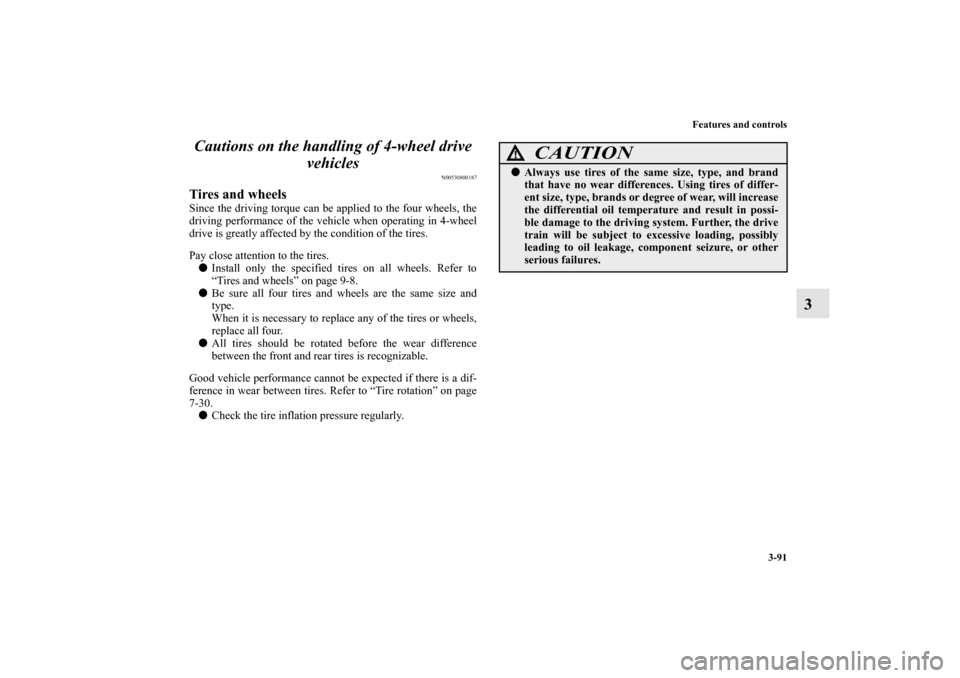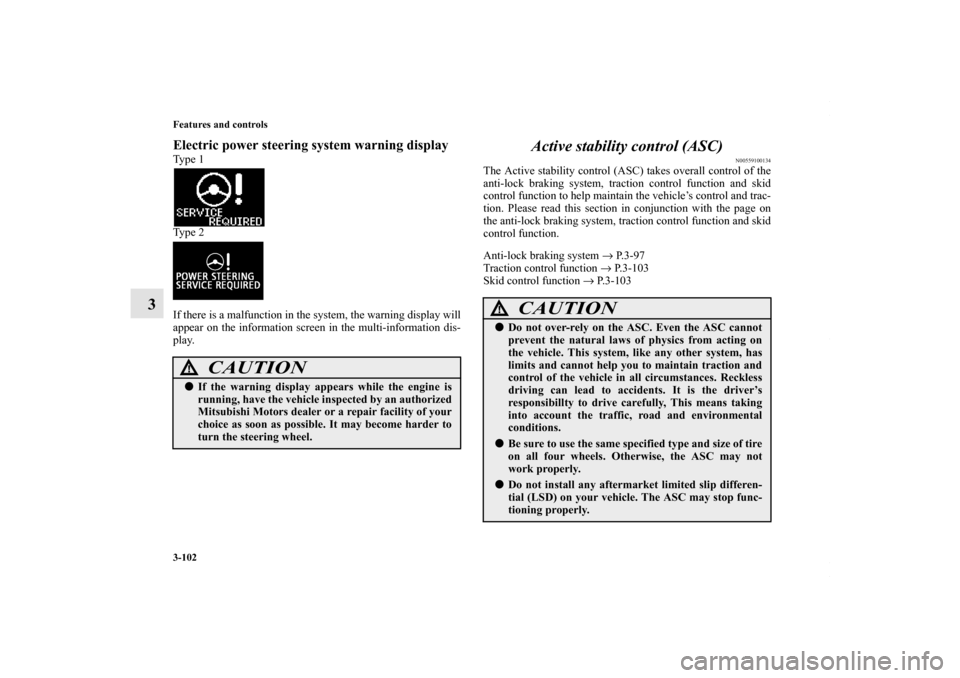Page 181 of 602

3-84 Features and controls
3Electronically controlled 4WD system
(if so
equipped)N00517200155
The electronically controlled 4WD system is an all-wheel drive
system that allows one of three drive modes to be selected with
a switch, in accordance with the driving conditions.
The following drive modes are available.
4-wheel drive operation requires special driving skills.
Carefully read the “4-wheel drive operation” section on page 3-
87 and take care to drive safely.
Drive mode-selectorThe drive mode can be changed by pressing the drive mode-
selector while the ignition switch or the operation mode is in
ON.
By pressing the drive mode-selector, the drive mode can be
changed in order of “2WD”, “4WD AUTO” and “4WD
LOCK”.
The drive mode is displayed as an interrupt display on the
information screen in the multi-information display when the
drive mode is changed.
After a few seconds, the information screen will then return to
its prior display.
Drive mode
Function
2WD This mode is for economical
driving on normal dry roads
and freeways.
Driving in front-wheel drive.
4WD AUTO The default mode.
This mode is for automatically
controlling the distribution of
driving torque to all four
wheels according to the driving
conditions.
4WD LOCK This mode is for driving in slip-
pery conditions such as on
snow-covered roads or sand.
The large amount of driving
torque that is applied to the rear
tires enables getting out of slip-
pery areas and powerful driving
is possible across all ranges.
BK0150700US.book 84 ページ
2012年3月22日 木曜日 午後6時46分
Page 185 of 602

3-88 Features and controls
3
�Note that the stopping distance required of the 4-wheel
drive vehicle differs very little from that of the front-
wheel drive vehicle. When driving on a snow-covered
road or a slippery, muddy surface, make sure that you
keep a sufficient distance between your vehicle and the
one ahead of you.
� The driving posture should be more upright; adjust the
seat to a good position for easy steering and pedal opera-
tion. Be sure to wear the seat belt.
� After driving on rough roads, check each part of the vehi-
cle and wash it thoroughly with water. Refer to the
“Inspection and maintenance following rough road opera-
tion” section and “Vehicle care and Maintenance” sec-
tions.Turning sharp cornersWhen turning a sharp corner in “4WD LOCK” or “LOCK”
position at low speed, a slight difference in steering may be
experienced similar to feeling as if the brakes were applied.
This is called tight corner braking and results from each of the
four tires being at a different distance from the corner. The phe-
nomenon is typical of 4-wheel drive vehicles. If this occurs,
either straighten out the steering wheel or change to another
mode.
On snowy or icy roadsSet the drive mode-selector to “4WD AUTO”, “4WD LOCK”
or “SNOW” in accordance with the road conditions, and then
gradually depress the accelerator pedal for a smooth start.NOTE�The use of snow tires is recommended.
� Maintain a safe distance between vehicles, avoid sudden
braking, and use engine braking (downshifting).Driving on sandy or muddy roadsSet the drive mode-selector to “4WD LOCK” or “LOCK” and
then gradually depress the accelerator pedal for a smooth start.
Keep the pressure on the accelerator pedal as constant as possi-
ble, and drive at low speed.
CAUTION
!�Setting the drive mode-selector to “4WD LOCK” or
“LOCK” position to drive on dry paved road will
increase fuel consumption, with possible noise gen-
eration.
CAUTION
!� Avoid sudden braking, sudden acceleration and
sharp turning. Skidding occurs and control of the
vehicle could be lost.
CAUTION
!�Do not force the vehicle or drive recklessly on sandy
surfaces. In comparison with normal road surfaces,
the engine and other drive-system components are
put under excessive strain when driving on such a
surface. This could lead to accidents.
BK0150700US.book 88 ページ 2012年3月22日 木曜日 午後6時46分
Page 188 of 602

Features and controls3-91
3
Cautions on the handling of 4-wheel drive
vehicles
N00530800187
Tires and wheelsSince the driving torque can be applied to the four wheels, the
driving performance of the vehicle when operating in 4-wheel
drive is greatly affected by the condition of the tires.
Pay close attention to the tires.
� Install only the specified tires on all wheels. Refer to
“Tires and wheels” on page 9-8.
� Be sure all four tires and wheels are the same size and
type.
When it is necessary to replace any of the tires or wheels,
replace all four.
� All tires should be rotated before the wear difference
between the front and rear tires is recognizable.
Good vehicle performance cannot be expected if there is a dif-
ference in wear between tires. Refer to “Tire rotation” on page
7-30. � Check the tire inflation pressure regularly.
CAUTION
!�Always use tires of the same size, type, and brand
that have no wear differences. Using tires of differ-
ent size, type, brands or degree of wear, will increase
the differential oil temperature and result in possi-
ble damage to the driving system. Further, the drive
train will be subject to excessive loading, possibly
leading to oil leakage, component seizure, or other
serious failures.
BK0150700US.book 91 ページ 2012年3月22日 木曜日 午後6時46分
Page 199 of 602

3-102 Features and controls
3
Electric power steering system warning displayType 1
Type 2
If there is a malfunction in the system, the warning display will
appear on the information screen in the multi-information dis-
play.
Active stability control (ASC)
N00559100134
The Active stability control (ASC) takes overall control of the
anti-lock braking system, traction control function and skid
control function to help maintain the vehicle’s control and trac-
tion. Please read this section in conjunction with the page on
the anti-lock braking system, traction control function and skid
control function.
Anti-lock braking system → P.3-97
Traction control function → P.3-103
Skid control function → P.3-103
CAUTION
!� If the warning display appears while the engine is
running, have the vehicle inspected by an authorized
Mitsubishi Motors dealer or a repair facility of your
choice as soon as possible. It may become harder to
turn the steering wheel.
CAUTION
!� Do not over-rely on the ASC. Even the ASC cannot
prevent the natural laws of physics from acting on
the vehicle. This system, like any other system, has
limits and cannot help you to maintain traction and
control of the vehicle in all circumstances. Reckless
driving can lead to accidents. It is the driver’s
responsibillty to drive carefully, This means taking
into account the traffic, road and environmental
conditions.�Be sure to use the same specified type and size of tire
on all four wheels. Otherwise, the ASC may not
work properly.�Do not install any aftermarket limited slip differen-
tial (LSD) on your vehicle. The ASC may stop func-
tioning properly.
BK0150700US.book 102 ページ 2012年3月22日 木曜日 午後6時46分